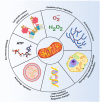The Chaperone TRAP1 As a Modulator of the Mitochondrial Adaptations in Cancer Cells
- PMID: 28405578
- PMCID: PMC5370238
- DOI: 10.3389/fonc.2017.00058
The Chaperone TRAP1 As a Modulator of the Mitochondrial Adaptations in Cancer Cells
Abstract
Mitochondria can receive, integrate, and transmit a variety of signals to shape many biochemical activities of the cell. In the process of tumor onset and growth, mitochondria contribute to the capability of cells of escaping death insults, handling changes in ROS levels, rewiring metabolism, and reprograming gene expression. Therefore, mitochondria can tune the bioenergetic and anabolic needs of neoplastic cells in a rapid and flexible way, and these adaptations are required for cell survival and proliferation in the fluctuating environment of a rapidly growing tumor mass. The molecular bases of pro-neoplastic mitochondrial adaptations are complex and only partially understood. Recently, the mitochondrial molecular chaperone TRAP1 (tumor necrosis factor receptor associated protein 1) was identified as a key regulator of mitochondrial bioenergetics in tumor cells, with a profound impact on neoplastic growth. In this review, we analyze these findings and discuss the possibility that targeting TRAP1 constitutes a new antitumor approach.
Keywords: allosteric ligands; heat shock proteins; kinase; mitochondria; post-translational modifications; reactive oxygen species; tumor metabolism; tumor necrosis factor receptor-associated protein 1.
Figures




References
-
- Stine ZE, Walton ZE, Altman BJ, Hsieh AL, Dang CV. MYC, metabolism, and cancer. Cancer Discov (2015) 5(10):1024–39.10.1158/2159-8290.CD-15-0507 - DOI - PMC - PubMed
Publication types
LinkOut - more resources
Full Text Sources
Other Literature Sources
Research Materials
Miscellaneous

